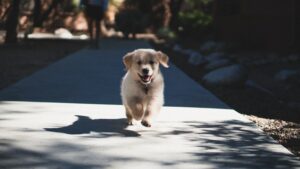Potty Training for Busy Owners: A Complete Guide to Success
Learn effective strategies and tips for potty training your puppy while juggling a busy schedule.
Potty Training for Busy Owners: Understanding Puppy Development and Readiness
When it comes to potty training puppies, it’s crucial for busy owners to understand the development and readiness of their furry companions. Similar to children, puppies have their own pace of learning and development. The average age for starting potty training a puppy is around 2 to 2 ½ months, and in some cases, it may extend up to 3 ½ months. This indicates that there’s no one-size-fits-all approach, and busy owners need to be patient and attentive to their puppy’s individual needs and learning curve.
Before initiating the potty training process, busy owners should consider their puppy’s potty style preferences and clothing choices. Some puppies may have a preference for certain surfaces or locations for pottying, while others may exhibit specific behaviors before eliminating. Understanding these preferences can help in tailoring the training approach to suit the puppy’s comfort and habits. Additionally, being mindful of the puppy’s clothing choices can make the training process smoother. For instance, some puppies may be uncomfortable with certain types of collars or harnesses, leading to reluctance during potty breaks. By considering these factors, owners can create a more conducive environment for successful potty training.
Furthermore, busy owners should bear in mind the importance of patience during the training process. Just like children, puppies may have accidents and setbacks, and it’s crucial not to apply unnecessary pressure or stress on them. Maintaining a positive and encouraging attitude, despite the challenges, can significantly contribute to the success of potty training. By acknowledging and respecting the individuality and developmental pace of their puppies, busy owners can foster a supportive and effective potty training experience for their furry companions.
Essential Supplies and Setup for Successful Potty Training
When it comes to potty training puppies, having the right supplies and setup can make a significant difference, especially for busy owners. Essential supplies include crates, pet gates, exercise pens, a designated potty spot, busy toys, treats, and cleanser. For example, a crate can be used to create a safe space for the puppy when unsupervised, pet gates can help in managing the puppy’s movement within the house, and designated potty spots can aid in establishing a consistent routine for the puppy. These supplies not only facilitate the training process but also contribute to a smoother experience for busy owners who may have limited time to monitor their puppies constantly.
In addition to the supplies, it’s important for busy owners to create a structured environment conducive to successful potty training. This includes setting a consistent daily schedule for potty breaks, using long-term confinement areas when necessary, and being aware of the risks associated with using newspaper for potty training [2, 4]. For instance, long-term confinement areas, such as exercise pens, can provide a safe space for the puppy when the owner is away, ensuring that the puppy is not left unsupervised but still has room to move around. Furthermore, understanding the potential drawbacks of using newspaper for potty training, such as the challenge of transitioning the puppy to pottying outdoors, can help busy owners make informed decisions about the training approach they want to take. Finally, for apartment dwellers, the emphasis should be on supervision and unwavering commitment to the training process, as well as the recognition of the fundamental role that consistency plays in successful potty training.
 Practical Tips and Strategies for Potty Training
Practical Tips and Strategies for Potty Training
When it comes to potty training, establishing a routine is crucial for busy owners. Setting specific times for potty breaks and consistently taking the puppy to the designated potty spot can help reinforce good habits and minimize accidents. For instance, taking the puppy out first thing in the morning, after meals, and before bedtime can be a part of this routine. By doing so, the puppy starts to understand when and where they should relieve themselves, making the training process more effective.
Understanding the puppy’s potty language is another essential strategy for successful potty training. Busy owners should pay attention to signs that indicate when the puppy needs to go, such as sniffing the ground, circling, or whining. By recognizing these cues, owners can proactively take the puppy to the designated potty area, ultimately preventing accidents indoors and reinforcing the desired behavior.
Additionally, implementing a reward system can be highly effective in encouraging and reinforcing potty training. For example, providing the puppy with treats, verbal praise, or a favorite toy immediately after they successfully potty outside can positively reinforce the behavior. This positive association encourages the puppy to continue using the designated potty area, making the training process more successful and efficient for busy owners.
Potty Training Methods for Busy Owners
When it comes to potty training methods for busy owners, it’s essential to consider options that align with the owner’s schedule and the puppy’s needs. For instance, finding a qualified daycare provider can be a beneficial option for busy owners who work long hours. Daycare facilities can provide a structured environment where puppies can learn potty training habits while being supervised by professionals. This not only helps in the potty training process but also ensures that the puppy gets the necessary socialization and exercise while the owner is at work, contributing to their overall well-being and development.
Another method that busy owners can explore is setting up a safe, puppy-proofed area with pee pads or newspaper. This option is particularly useful for owners who may not have access to a daycare facility or prefer to keep their puppies at home during the day. By creating a designated area with the necessary potty supplies, such as pee pads, owners can provide their puppies with a consistent and accessible space to attend to their potty needs while they are away. This method requires careful planning and setup to ensure that the puppy is safe and comfortable in their designated area, and it can be an effective solution for busy owners striving to balance work commitments with their puppy’s potty training requirements.
In both cases, it’s crucial to emphasize the gradual transition from indoor to outdoor pottying as the puppy progresses in their training. This ensures that the puppy develops the appropriate potty habits while accommodating the owner’s schedule, promoting a successful and harmonious potty training experience for both the owner and the puppy. [4]
 Night Time Training and Transitioning
Night Time Training and Transitioning
Night time training is a crucial phase in the potty training process for busy puppy owners. It’s imperative to ensure that the puppy has mastered day time training before embarking on night time training. This means that the puppy should consistently demonstrate understanding and control over their bathroom habits during the day before transitioning to night time training. This approach helps to avoid confusion and sets clear expectations for the puppy.
Busy owners should anticipate potential setbacks during the night time training phase. Accidents are common, especially during the initial stages of night time training. However, it’s essential to remain patient and maintain a positive attitude throughout the process. Encouraging the puppy through positive reinforcement and gentle guidance can help them adapt to the new routine more effectively.
Furthermore, managing night time training involves creating a comfortable and secure environment for the puppy. This can include providing a designated sleeping area, ensuring the room is dark and quiet, and offering comforting items such as a favorite toy or a soft blanket. By prioritizing the puppy’s comfort and confidence during the night time training process, busy owners can help alleviate any anxiety or stress the puppy may feel during this transition period, ultimately leading to more successful potty training outcomes.

